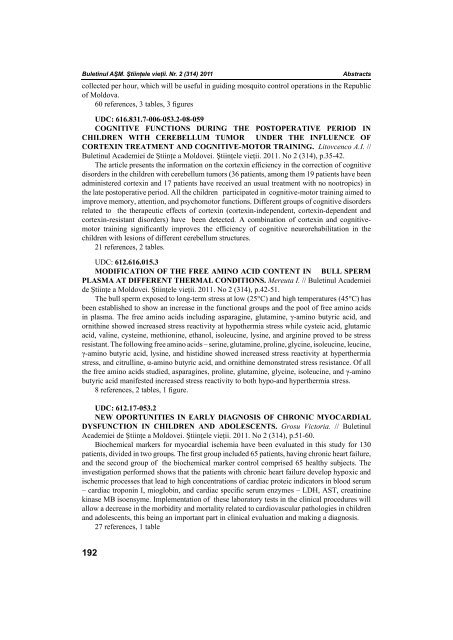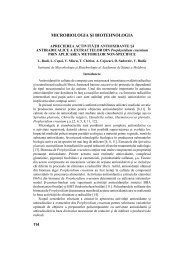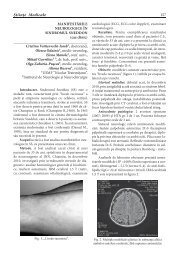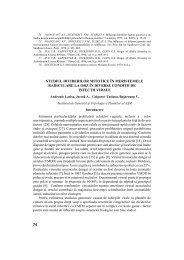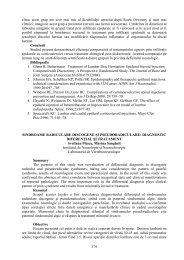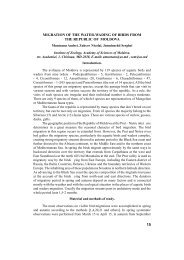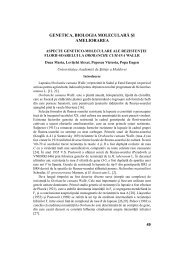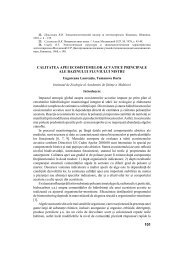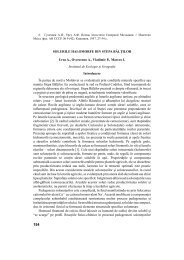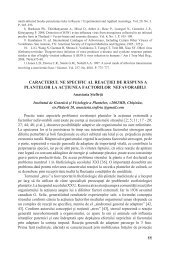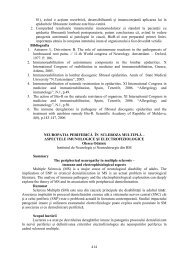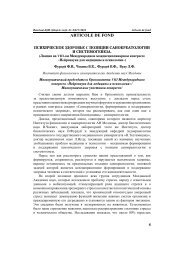209 CONTENTS
209 CONTENTS
209 CONTENTS
You also want an ePaper? Increase the reach of your titles
YUMPU automatically turns print PDFs into web optimized ePapers that Google loves.
Buletinul AŞM. Ştiinţele vieţii. Nr. 2 (314) 2011<br />
collected per hour, which will be useful in guiding mosquito control operations in the Republic<br />
of Moldova.<br />
60 references, 3 tables, 3 gures<br />
UDC: 616.831.7-006-053.2-08-059<br />
COGNITIVE FUNCTIONS DURING THE POSTOPERATIVE PERIOD IN<br />
CHILDREN WITH CEREBELLUM TUMOR UNDER THE INFLUENCE OF<br />
CORTEXIN TREATMENT AND COGNITIVE-MOTOR TRAINING. Litovcenco A.I. //<br />
Buletinul Academiei de Ştiinţe a Moldovei. Ştiinţele vieţii. 2011. No 2 (314), p.35-42.<br />
The article presents the information on the cortexin ef ciency in the correction of cognitive<br />
disorders in the children with cerebellum tumors (36 patients, among them 19 patients have been<br />
administered cortexin and 17 patients have received an usual treatment with no nootropics) in<br />
the late postoperative period. All the children participated in cognitive-motor training aimed to<br />
improve memory, attention, and psychomotor functions. Different groups of cognitive disorders<br />
related to the therapeutic effects of cortexin (cortexin-independent, cortexin-dependent and<br />
cortexin-resistant disorders) have been detected. A combination of cortexin and cognitivemotor<br />
training signi cantly improves the ef ciency of cognitive neurorehabilitation in the<br />
children with lesions of different cerebellum structures.<br />
21 references, 2 tables.<br />
UDC: 612.616.015.3<br />
MODIFICATION OF THE FREE AMINO ACID CONTENT IN BULL SPERM<br />
PLASMA AT DIFFERENT THERMAL CONDITIONS. Mereuta I. // Buletinul Academiei<br />
de Ştiinţe a Moldovei. Ştiinţele vieţii. 2011. No 2 (314), p.42-51.<br />
The bull sperm exposed to long-term stress at low (25°C) and high temperatures (45°C) has<br />
been established to show an increase in the functional groups and the pool of free amino acids<br />
in plasma. The free amino acids including asparagine, glutamine, γ-amino butyric acid, and<br />
ornithine showed increased stress reactivity at hypothermia stress while cysteic acid, glutamic<br />
acid, valine, cysteine, methionine, ethanol, isoleucine, lysine, and arginine proved to be stress<br />
resistant. The following free amino acids – serine, glutamine, proline, glycine, isoleucine, leucine,<br />
γ-amino butyric acid, lysine, and histidine showed increased stress reactivity at hyperthermia<br />
stress, and citrulline, α-amino butyric acid, and ornithine demonstrated stress resistance. Of all<br />
the free amino acids studied, asparagines, proline, glutamine, glycine, isoleucine, and γ-amino<br />
butyric acid manifested increased stress reactivity to both hypo-and hyperthermia stress.<br />
8 references, 2 tables, 1 gure.<br />
UDC: 612.17-053.2<br />
NEW OPORTUNITIES IN EARLY DIAGNOSIS OF CHRONIC MYOCARDIAL<br />
DYSFUNCTION IN CHILDREN AND ADOLESCENTS. Grosu Victoria. // Buletinul<br />
Academiei de Ştiinţe a Moldovei. Ştiinţele vieţii. 2011. No 2 (314), p.51-60.<br />
Biochemical markers for myocardial ischemia have been evaluated in this study for 130<br />
patients, divided in two groups. The rst group included 65 patients, having chronic heart failure,<br />
and the second group of the biochemical marker control comprised 65 healthy subjects. The<br />
investigation performed shows that the patients with chronic heart failure develop hypoxic and<br />
ischemic processes that lead to high concentrations of cardiac proteic indicators in blood serum<br />
– cardiac troponin I, mioglobin, and cardiac speci c serum enzymes – LDH, AST, creatinine<br />
kinase MB isoensyme. Implementation of these laboratory tests in the clinical procedures will<br />
allow a decrease in the morbidity and mortality related to cardiovascular pathologies in children<br />
and adolescents, this being an important part in clinical evaluation and making a diagnosis.<br />
27 references, 1 table<br />
192<br />
Abstracts


